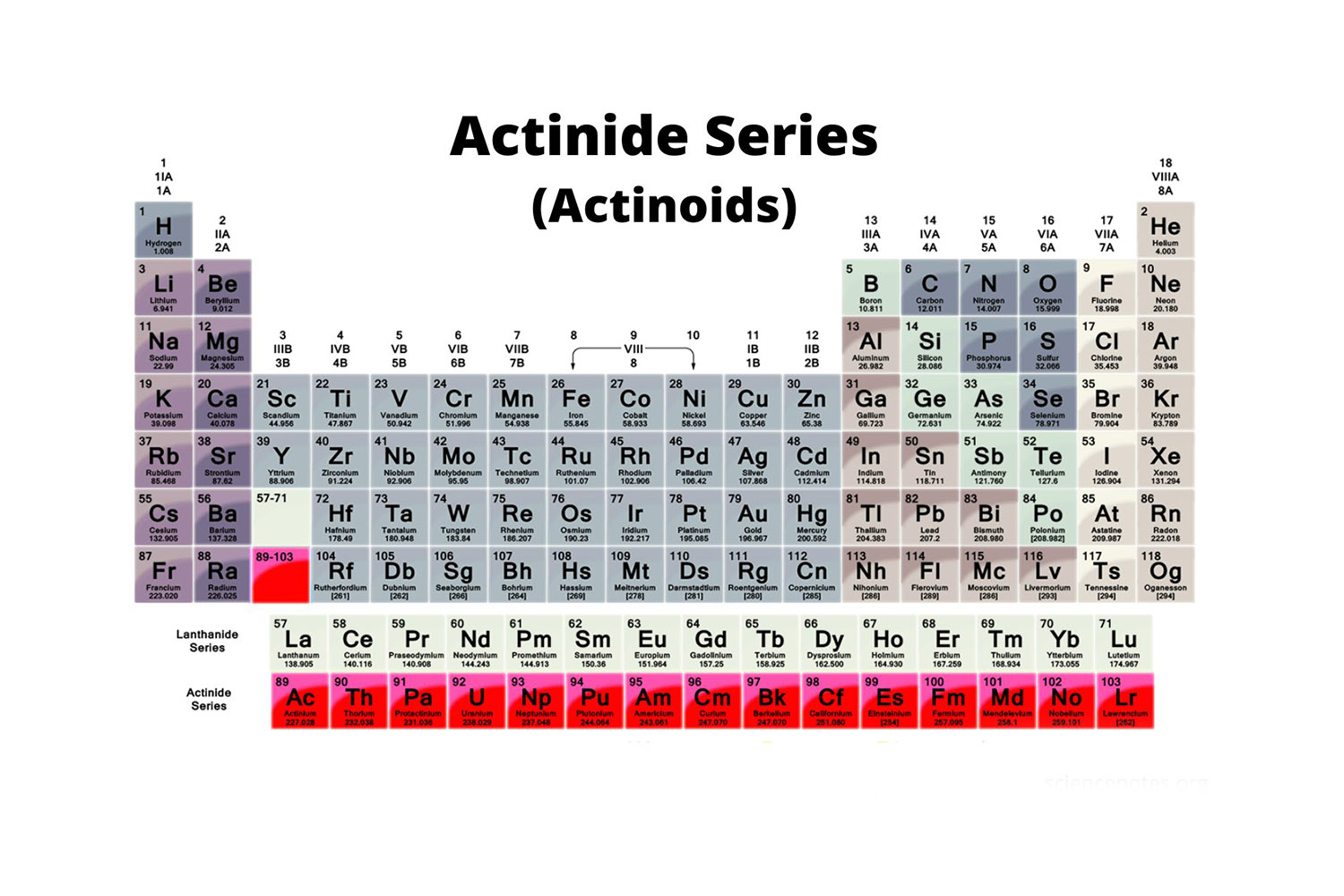
The world of chemistry is filled with fascinating elements, and one group that never fails to captivate the imagination is the actinides. These elements belong to the bottom row of the periodic table, known as the actinide series. From uranium to lawrencium, actinides possess unique properties and play a vital role in various fields, including nuclear energy, medicine, and research.
In this article, we will delve into the world of actinides and explore 19 captivating facts that shed light on their distinctive characteristics and applications. From their discovery and isolation to their radioactive properties and potential future uses, join us on this journey as we uncover the intriguing secrets of these elusive elements.
Key Takeaways:
- Actinides, a group of 15 elements, are vital for nuclear power, medical imaging, and cancer treatment. Their unique properties contribute to scientific research and our understanding of atomic structure.
- Actinides, like uranium and plutonium, have diverse industrial uses and impact the environment. Ongoing research aims to improve nuclear power generation and waste management strategies.
Actinides are a series of 15 elements
The actinide series consists of 15 elements, from actinium to lawrencium, in the periodic table. These elements are all radioactive and exhibit similar chemical properties.
Actinides have unique electron configurations
Actinides have electron configurations that follow the pattern [Rn] 5f1-14 6d0-1 7sThis unique arrangement of electrons contributes to their distinctive chemical behavior.
Uranium is the most widely known actinide
Uranium, with its atomic number 92, is the most well-known actinide. It is commonly used as a fuel in nuclear reactors and has important applications in both civil and military contexts.
Actinides have various industrial uses
Actinides have numerous industrial applications, including the production of nuclear power, the synthesis of radioactive isotopes for medical imaging, and the development of radiation therapy for cancer treatment.
Plutonium is a key component in nuclear weapons
Plutonium, an actinide, is a crucial element in the production of nuclear weapons. Its ability to sustain a chain reaction has made it highly valuable in both peaceful and military nuclear programs.
Actinides are vital for scientific research
Actinides play a significant role in scientific research, particularly in the fields of nuclear physics and chemistry. Their unique properties and behavior help researchers better understand atomic structure and the nature of radioactivity.
Actinides have complex radioactive decay chains
Actinides undergo complex radioactive decay processes, leading to the formation of daughter isotopes. These decay chains can last for thousands of years, releasing radiation during the process.
Actinides can be found in natural deposits
Some actinides, such as uranium and thorium, can be found in significant quantities in Earth’s crust. These natural deposits serve as important sources for both energy production and scientific exploration.
Actinides have multiple oxidation states
Actinides exhibit a wide range of oxidation states, ranging from +3 to +This versatility allows them to form various chemical compounds and participate in diverse chemical reactions.
Neptunium was the first synthetic actinide
Neptunium, discovered in 1940, was the first synthetic actinide produced by human-made processes. It marked a significant milestone in the study of transuranium elements.
Some actinides have practical uses in nuclear medicine
Actinides like americium and curium are utilized in certain diagnostic and therapeutic applications in nuclear medicine, aiding in the detection and treatment of various medical conditions.
Actinides have high melting points
Most actinides possess exceptionally high melting points compared to other elements on the periodic table. This property, combined with their radioactive nature, makes handling and processing actinides a challenging task.
Actinides can be used as catalysts
Certain actinides, such as uranium and thorium, can serve as catalysts in chemical reactions, promoting the conversion of reactants into desired products. This characteristic has practical implications in industries like petroleum refining.
Actinides are essential for the study of atomic structure
Actinides provide valuable insights into the nature of atomic structure and the behavior of electrons within atoms. Scientific investigations into actinides have contributed significantly to our understanding of fundamental principles in chemistry and physics.
Actinides exhibit diverse magnetic properties
Actinides display a wide range of magnetic behaviors, including non-magnetic, paramagnetic, and antiferromagnetic properties. These properties make them intriguing subjects of study for researchers interested in magnetism and its applications.
Actinides can form stable coordination compounds
Actinides have the ability to form stable coordination compounds due to their flexible bonding arrangements. These complexes find applications in various fields, including catalysis, materials science, and environmental remediation.
Some actinides have unusual luminescent properties
Certain actinides, such as uranium and plutonium, exhibit unique luminescent properties that make them useful in materials and analytical chemistry, as well as in the development of specialized sensors and detectors.
Actinides have a significant impact on the environment
Actinides, particularly radioactive isotopes like plutonium-239, pose environmental challenges due to their long half-lives and potential for bioaccumulation. Proper management and disposal of actinide wastes are essential to minimize their impact on ecosystems.
Actinides are part of ongoing nuclear research and development
Actinides continue to be the focus of extensive research in the nuclear industry, aiming to improve nuclear power generation, develop advanced nuclear fuels, and enhance waste management strategies.
In conclusion, the 19 captivating facts about actinides highlight their unique properties, wide-ranging applications, and significant contributions to scientific advancements. Their radioactive nature, complex chemistry, and profound influence in various fields make actinides an intriguing subject of study.
Conclusion
Actinides are a fascinating group of elements that have captivated scientists for decades. From their unique electronic configurations to their role in nuclear energy, actinides offer a world of scientific exploration. Understanding these elements is not only crucial in terms of basic chemistry but also has implications for various fields such as energy production, environmental science, and even medicine. The 19 captivating facts we’ve explored in this article only scratch the surface of what is still to be discovered about actinides. As scientists continue to delve deeper into their properties and applications, we can look forward to unlocking even more of their secrets.
FAQs
1. What are actinides?
Actinides are a series of chemical elements that belong to the Actinide series in the Periodic Table. They are characterized by the filling of 5f orbitals with electrons.
2. What is the significance of actinides?
Actinides have numerous practical applications, including nuclear power generation, radioisotope production for medical use, and scientific research.
3. Are actinides radioactive?
Yes, actinides are highly radioactive due to their unstable atomic nuclei. This property makes them valuable for energy production but also poses challenges in terms of handling and disposal.
4. How are actinides used in nuclear reactors?
Actinides such as uranium and plutonium are utilized as fuel in nuclear reactors. These elements undergo nuclear fission, releasing energy in the form of heat which is then converted into electricity.
5. Are actinides found naturally on Earth?
Yes, actinides are found in trace amounts in the Earth’s crust. Uranium and thorium are the two most abundant actinides in the Earth’s crust.
6. Can actinides be found in living organisms?
Actinides have a strong affinity for biological molecules and can be taken up by living organisms. However, their toxic nature and long half-lives make them potentially harmful to living systems.
Was this page helpful?
Our commitment to delivering trustworthy and engaging content is at the heart of what we do. Each fact on our site is contributed by real users like you, bringing a wealth of diverse insights and information. To ensure the highest standards of accuracy and reliability, our dedicated editors meticulously review each submission. This process guarantees that the facts we share are not only fascinating but also credible. Trust in our commitment to quality and authenticity as you explore and learn with us.


